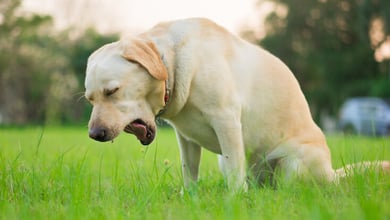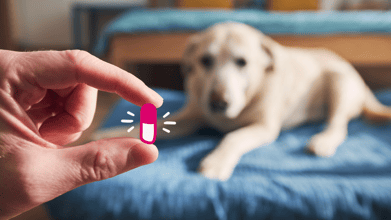Common Reasons for Excessive Panting in Dogs & When to Call Your Vet

Table of Contents
If you’re a doggy daddy or pup parent, you've probably seen your four-legged friend panting now and then. But what if your dog’s panting seems excessive?
Can excessive dog panting or noisy breathing in dogs be a sign of a health issue?
Read on to discover the possible causes of excessive dog panting and when to call the vet.
What Causes Panting in a Normal Dog?
Panting in a normal dog is a common and natural occurrence. Healthy dogs may pant when they feel warm, excited, anxious, or tired after exercise. As long as the panting is not excessive, there is usually no cause for concern.
So, How Much Dog Panting Is Excessive?
Of course, there’s no specific amount of panting that is 'too much' for any dog. Dogs are individuals, and the amount of panting they do will depend a bit on their breed, age, fitness, and lifestyle.
For example, a very unfit dog may pant for longer after a walk than a very fit and active dog. The most important thing that will help you decide whether your dog's panting is excessive is knowing what's normal for them. Please don't panic, though; you'll get to know their normal panting behavior over time.
Once you're aware of when they usually pant and for how long, you'll be able to spot any changes. As a rule, dogs should recover from exertion or heat within five to ten minutes. If they’re still panting after this despite resting in a cool, shady spot, this may be excessive.
Excessive panting might also mean your dog pants in a situation where they didn't use to, so it’s not only about the duration of the panting but also the circumstances.
What are the Possible Causes of Excessive Dog Panting?
Excessive panting in dogs can stem from heatstroke, heart or lung disease, Cushing's disease, pain, or anxiety. Each cause has distinct triggers, from hot weather to physical discomfort or stress, making it crucial to identify the root cause for appropriate treatment. Here's a breakdown of each possible cause:
Heatstroke
Heatstroke is life-threatening and affects more dogs than you might think. On a hot summer's day, it might be really tempting to get everyone out of the house into the fresh air for the day, including your furry family members. However, walking your dog in the summer when it's hot puts them at risk of heatstroke.
In fact, it doesn't have to be exceptionally hot; just a warm day can cause heatstroke if your dog is exerting itself and doesn’t have access to shade and water to cool off.
Heatstroke is when a dog’s body temperature rises, and it cannot cool down effectively. Dogs can only lose heat by panting and via small amounts of sweat from their paws, and both methods are inefficient.
Once your dog’s temperature gets too high, they risk seizures, brain damage, organ failure, and even death. To avoid heatstroke, you should only walk your dog at dusk or dawn on warm days and even skip a walk altogether if it feels too warm.
Heart disease
If your dog develops a heart problem, you might notice that they’re suddenly not able to run or walk for as long as they used. They might tire more easily and pant for a while after even a short walk.
Heart problems might include abnormal heart valves, abnormal heart rhythm, cardiomyopathy, or congestive heart failure. Other symptoms that you might notice include their tongue or gums becoming pale or blue-tinged, coughing, labored breathing, or collapse.
Lung disease
Some lung conditions may also cause your dog to struggle with exercise. Just like heart disease, you might notice your dog's tongue and gums don't look so pink. You might also see them coughing and breathing faster or with more effort than normal. Lung conditions that may cause panting include pneumonia, severe inflammation, lungworm, and certain cancers.
Cushing’s disease
Cushing’s disease, also known as hyperadrenocorticism, is caused by an overactive adrenal gland. The adrenal gland is responsible for producing the steroid hormone cortisol, as well as having other roles in fluid regulation. Too much cortisol leads to symptoms like excessive panting and excessive thirst and hunger.
You might also notice your dog's skin and fur have become thinner, and they’ve developed a pot-bellied appearance. Over time, Cushing’s can lead to diabetes and even congestive heart failure.
Pain
One of the most common causes of panting is pain. So, if your dog is panting, it could be a sign that they are painful. Sometimes the cause of the pain is obvious, especially if there’s been a recent trauma. However, some causes of pain, like arthritis, cystitis, back pain, or toothache, might not be so obvious. You can read more about the signs that your dog is in pain here.
Anxiety
If your dog suffers from occasional anxiety that’s temporary, then you don’t need to worry too much. However, if your dog experiences severe anxiety and stress, it can be distressing for both of you. Dog anxiety symptoms include panting, pacing, barking, whining, and even damaging furniture by scratching or chewing. Sometimes it's easy to pinpoint the cause of your dog's anxiety.
For instance, they probably have separation anxiety if they follow you around constantly and seem to become anxious when you put your shoes on and grab your keys. Equally, if they start panting when they see another dog or when they hear a firework in the distance, you can see what the trigger is. However, not all stress triggers are apparent, and you might need your vet's help.
Should My Pet Be Seen by a Veterinarian?
1. Have you noticed changes in your pet’s appetite?
2. Does your pet have diarrhea or loose stools?
3. Have you noticed changes in your pet’s thirst/water consumption?
4. Is your pet having accidents in the house?
5. Is your pet pacing and unable to settle?
6. Is your pet panting more than usual?
7. Is your pet whining or vocalizing more than usual?
8. Is your pet shaking more than usual?
9. Is your pet hiding or avoiding physical contact more than usual?
10. Is your pet more lethargic and sleeping more than usual?
11. Are you concerned about changes in your pet’s behavior?
12. Is your pet scratching their ears?
13. Is your pet licking their paws more than usual?
14. Does your pet have a rash?
15. Is your pet moving more slowly than usual or having a harder time getting up or down?
View Results
Should My Pet Be Seen by a Veterinarian?
1. Have you noticed changes in your pet’s appetite?
2. Does your pet have diarrhea or loose stools?
3. Have you noticed changes in your pet’s thirst/water consumption?
4. Is your pet having accidents in the house?
5. Is your pet pacing and unable to settle?
6. Is your pet panting more than usual?
7. Is your pet whining or vocalizing more than usual?
8. Is your pet shaking more than usual?
9. Is your pet hiding or avoiding physical contact more than usual?
10. Is your pet more lethargic and sleeping more than usual?
11. Are you concerned about changes in your pet’s behavior?
12. Is your pet scratching their ears?
13. Is your pet licking their paws more than usual?
14. Does your pet have a rash?
15. Is your pet moving more slowly than usual or having a harder time getting up or down?
Share Quiz
Signs of Excessive Panting in Dogs
If you notice any of the following signs along with excessive panting, it's important to consult a vet:
- Rabid or shallow breathing
- Open-mouthed breathing
- Excessive salivation
- Restlessness or anxiety
- Lethargy or weakness
- Changes in gum color
- Coughing or wheezing
- Increased thirst
- Loss of appetite
- Behavioral changes
- Physical discomfort
When to See a Vet
If your dog has started panting more often or for longer than before, and you can’t find an obvious or fixable cause, it’s time to see a vet. This is especially important if panting isn’t their only symptom. Be sure to keep an eye out for changes in their thirst, appetite, and how often they pee because your vet might ask you some questions about it.
It's also helpful to make a mental note of which situations cause your dog to pant – whether it's after a strenuous walk or when you try to leave the house. This information will give your vet some clues about what the problem could be. Consider scheduling a pet check-up at home or a virtual vet visit with BetterVet.
"I used a free consultation with Dr. Scott. He was highly knowledgeable, and provided directly relevant and helpful medical advice that got to not only possible explanations for symptoms but also underlying disease or disordered factors that could be at play. He helped me directly diagnosis a breathing issue via video and ultimately understand my dogs possible overall condition better than any of the two vets I had been to in person. I highly recommend better vet. Wish I had used them for the past seven years."
Marilyn Haas BetterVet Seattle, Mobile Vet Services
Summary
As a pet parent, you might think panting is pretty normal behavior. But if your dog’s panting is excessive or they have noisy breathing or breathing distress, it could be a sign of a health problem. So, if your dog starts panting in situations where they didn’t before, schedule a visit with a vet to discuss the possible causes and treatment options available.
Hassle-free In-Home Pet Sick Visits
When your pet isn't feeling well, the last thing you want is a stressful trip to the vet. Our in-home sick pet visits offer a calm, stress-free alternative.
Frequently Asked Questions
Why does my dog pant so much, and is it normal?
Dogs naturally pant, especially in warm weather or after exercise. However, excessive panting can indicate discomfort or health issues like heatstroke, heart disease, or anxiety.
How do I know if my dog is panting too much?
If your dog is exhibiting noisy open-mouth breathing, it could be a sign of excessive panting. Additionally, compare their panting to their normal patterns. Dogs should recover from exertion or heat within five to ten minutes. Additionally, if the panting persists despite resting in a cool spot or occurs in unusual situations. In that case, it may indicate that your dog is panting too much and could be experiencing underlying issues.
Why is my dog excessively panting for no reason?
Dogs pant for many reasons, and often it’s normal. However, if they’re panting excessively, it could be due to anxiety, pain, heatstroke, or an underlying health condition. Therefore, it’s best to get them checked over by a veterinarian.
When should I worry about my dog panting?
If your dog is panting more than normal or has other symptoms as well as panting, you should make an appointment to see a veterinarian. The vet will be able to help determine the cause and whether they need any tests or treatment.
Why is my dog panting while resting?
If your dog is panting while resting, it could be a sign of an underlying health problem, such as respiratory issues, heart problems, or obesity. However, it could also be a normal response to a warm environment. Dogs pant to keep themselves cool when they're too warm.






